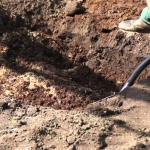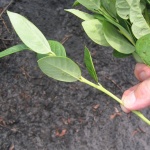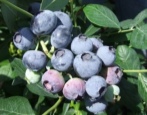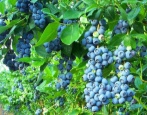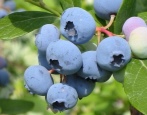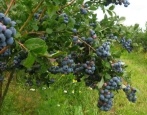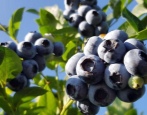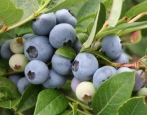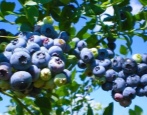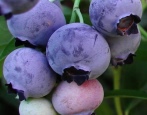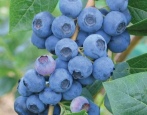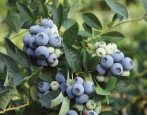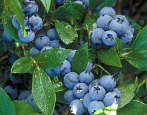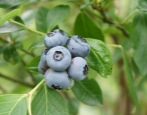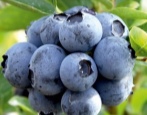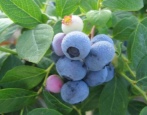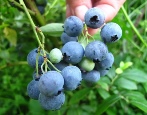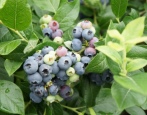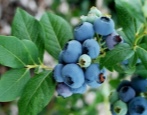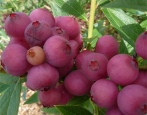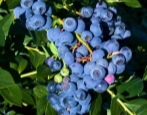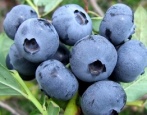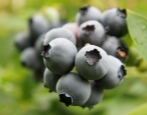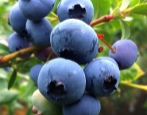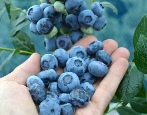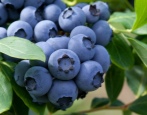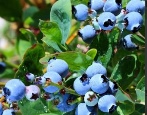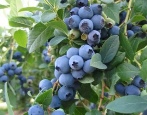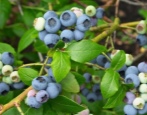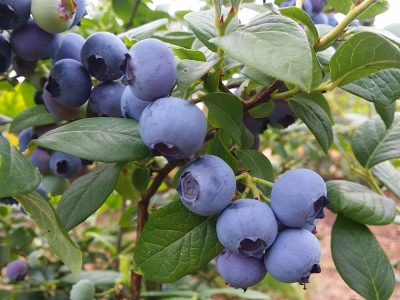
- Name synonyms: Blue Gold
- Ripening terms: mid-late
- Growth type: medium-sized
- Bush height, m: 1,2-1,5
- Taste: sweet and sour
- Yield: high
- Average yield: 4.5-7 kg per bush
- Fruit size: medium
- Fruit shape: rounded
- Fruit color: light blue or blue with a silvery tint
For the most part, we are used to enjoying the gifts of the forest, including fragrant and delicious blueberries. Today we'll talk about the Bluegold garden blueberry, which is in no way inferior to the forest version, and even surpasses it in many respects. A little patience, a little work, and you will be provided with this wonderful and healthy berry for at least 50 years.
Breeding history
The Bluegold culture is the result of the fruitful work of American scientists. It was bred by A. Draper in 1989, and various tall blueberry species that productively develop in wetlands became the breeding material.
In the twentieth century, culture, due to its high qualities, gained significant distribution both in America and in Europe. It was brought to us in the 90s, and from that moment it began to be grown both in summer cottages and in small farm estates. It has proven itself most productively in the middle latitudes of Russia, in the Urals and the Far East.
Description of the variety
These beautiful, medium-sized, powerful and spreading deciduous shrubs reach a height of 1.2-1.5 m. They also have good decorative properties. The crown is formed by straight-growing, solid branches lumbering up to the top, the diameter of which reaches 3 cm. The shoots develop strong and intensively branching. Leaflets are obovate, slightly elongated, compacted, smooth, bright green shades, with well-visible reticular veins of dark beige tones. In autumn, they acquire a bright yellow-orange or yellow-red color. Petioles are elongated, harsh. The roots are fibrous, superficial. The flowers are small, pitcher-shaped, with five teeth, pinkish tones. Up to 5-7 pieces are formed on one brush.
Blueberry bushes, with proper care, are quite capable of bearing fruit of stable quality and yield for 50 years. All that is required for this is timely pruning of fast-growing shoots and abundant irrigation during dry periods.
Of the advantages of culture, gardeners noted:
- high level of frost resistance;
- self-pollination;
- stable decent yields;
- good keeping quality and transportability of fruits;
- bright and memorable taste properties.
Also in the reviews there are the following disadvantages:
- low level of drought resistance;
- tendency to overgrow with small branches;
- the need for frequent pruning;
- the tendency of ripe fruits to shedding;
- the aggressiveness of the bushes to seize neighboring territories.
Fruit characteristics
The fruits of the culture are medium in size (15-18 mm), weighing up to 2.1 g, round and slightly flattened configuration. The color of the berries is light blue or blue with a silvery tinge. The peel is not thick, firm, elastic, well resistant to mechanical stress, with a noticeable waxy coating. The consistency is dense, initially light green, and later light blue, contains up to 9.6% sugar. Perianth scars are small. Berries fall off when overripe. Stores well in refrigeration units for up to 3 weeks.Do not allow the berries to overripe: the peel loses its elasticity and begins to crack. The fruits are good when fresh. They are ideal for making homemade jams, preserves and compotes. Good in desserts, cereals and cereals.
Taste qualities
By its taste, the fruits are sweet and sour. Tasting score in points - 4.3.
Ripening and fruiting
In terms of ripening of berries, the culture is medium late. The fruiting period falls in mid-July, the berries ripen synchronously. Bushes bear fruit annually.
The bushes bloom in April-May, but the timing may vary slightly due to the peculiarities of the climate in certain regions.
Yield
The plant is high-yielding, the average volume is 4.5-7 kg per bush.
Self-fertility and the need for pollinators
The culture is self-pollinated, does not require additional pollination.
Growing and care
The best time for planting bushes is spring. In the southern regions, the disembarkation time can be postponed until the fall. The disembarkation procedure is standard. In this case, the landing grooves are prepared 40 cm deep and 80 cm in diameter. The bottom of the grooves is lined with logs, and then filled with a loosened substrate. The root collars are slightly deepened. After planting, a layer of peat or sawdust (10 cm) is used as mulch.
An excess of irrigation must not be allowed. Control over the state of soil moisture is required. If the soil is dry, then it should be moistened (up to 20 cm deep). Particular attention should be paid to the bushes in the summer, irrigating them after three days. Irrigation is carried out under the roots (10-15 l / bush). Irrigation should not be done on rainy days.
They begin to feed the culture 2 years after planting. Initially, ammonium sulfate additives are carried out. In the summer, complex supplements with sulfur, calcium, phosphorus, magnesium and potassium are useful. With an interval of about 10 days, colloidal sulfur is added (1 g of the preparation is diluted in 1 liter of liquid).
The weeding procedure is mandatory, it is done carefully so as not to injure the surface roots of the bushes.
Bushes at the age of 6 years require systematic care, from which the drying up and starting to die off branches are cut off. The crowns of the culture should not thicken too much, since the fruits begin to become small and sour. The procedure for forming bushes is carried out in 5-8 shoots.

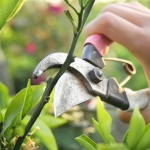
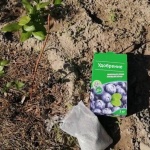
Disease and pest resistance
The culture has an average level of disease resistance. Let's consider those that can be encountered in practice.
- Mummification of berries. First, they dry out and a noticeable grayish coating appears on them. In the future, ripe fruits wrinkle, the peel becomes orange, and then turns brown. This disease is better prevented. In the spring, the bushes are treated with "Topsin" or Bordeaux mixture. Periodically they need to be sprayed with fungicides. Removal of fallen leaves and infected fruits is mandatory.
- Spotting is characterized by the appearance of red spots on the foliage, leading to its fall. Here they use "Rovral" and Bordeaux composition.
The necessary preventive measures are:
- competent agrotechnical care;
- mulching procedures;
- periodic use of special drugs.
Sometimes the bushes are subject to pest attacks by fruit moths and gall midges. Control and prevention measures are standard.
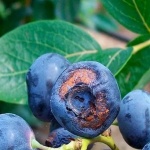
Winter hardiness and the need for shelter
Special preparation of the bushes for the winter period is optional: the culture will perfectly withstand fairly severe frosts (up to -35 degrees). Phosphorus and potassium supplements in liquid form should be added under the bushes. But young seedlings, even in the middle lane, should be covered. The branches of the bushes are gently pressed to the soil, fixed and covered with spruce branches from above. Small snowdrifts are organized in winter.

Location and soil requirements
The culture develops productively and bears fruit in sunny places with sufficient access to fresh air. For the soil, it is not so much its chemical composition that is relevant as its mechanical properties: it should be light and well aerated. Podzolic, slightly acidic soils (pH 3.5-4.5) are desirable. In cases of proximity to underground moisture, the culture is placed on a hill, draining the planting depressions. The seedlings should be sheltered from strong winds and drafts.
